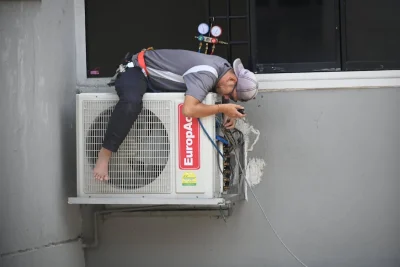
Transforming your home with a fresh coat of paint on stucco can breathe new life into its exterior, boosting curb appeal and protecting against the elements. However, achieving a stunning finish requires more than picking a colour; it starts with thorough stucco preparation. Properly preparing stucco ensures that paint adheres correctly, preventing issues like peeling and cracking down the road. This guide explores essential steps to effectively prepare your stucco surface, from cleaning and repairing to priming and painting. Whether you’re a seasoned DIYer or seeking assistance from professionals like Calgary Golden Trowel Stucco Painting, understanding each phase of the preparation process will set the stage for a long-lasting, beautiful result.
Stucco Has Unique Challenges
While an attractive and durable exterior finish, Stucco presents specific challenges that can complicate its maintenance and painting.
- Textured Surface: The rough texture of stucco can make it easier for paint to adhere properly with the right preparation. This means thorough cleaning and priming are necessary before painting to ensure a smooth finish.
- Porosity: Stucco is highly porous and can absorb moisture. If not adequately sealed with a primer, the paint may penetrate too deeply into the surface, leading to potential peeling or blistering over time.
- Cracking: Small cracks can develop over time due to weather changes and settling. These cracks need to be repaired before any painting occurs. If left unaddressed, they can expand and lead to more significant damage.
- Weather Exposure: Exposure to various weather conditions can cause paints to wear out faster on stucco surfaces. Choosing the best paint for stucco to withstand UV rays and moisture is crucial for long-lasting results.
- Maintenance Requirements: Regular maintenance is essential to keep stucco looking its best. This includes periodic cleaning to prevent mould growth and routine inspections for any signs of damage.
Understanding and addressing these challenges through proper stucco preparation can result in a beautiful and enduring finish. Engaging professionals like Calgary Golden Trowel Stucco Painting can help ensure these tasks are completed correctly, yielding a stunning outcome.
Why Stucco Preparation is Essential: A Step-by-Step Guide
Proper stucco preparation is key to achieving a beautiful and long-lasting paint job. Skipping steps can lead to poor adhesion, peeling, or an uneven finish. Here’s a detailed guide on preparing stucco for painting, ensuring the best results for your exterior surfaces.
Step 1: Thorough Cleaning
Stucco cleaning before painting sets the foundation for success. Dirt, grime, mould, and chalk buildup can hinder paint adherence.
- Power Washing: Use a pressure washer between 2,800 and 3,100 psi to clean the stucco effectively. This method removes accumulated debris without damaging the surface.
- Soft Washing for Delicate Areas: For older or fragile stucco, consider a soft washing technique using a low-pressure stream mixed with a mild detergent. This prevents water from infiltrating cracks while still providing a thorough cleaning.
Take time to let the stucco dry completely after washing. This step ensures moisture doesn’t get trapped beneath the paint.
Step 2: Inspect and Repair Damage
After cleaning, inspect the stucco carefully for any signs of damage.
- Stucco Cracks Repair: Identify small cracks that need attention. Using a quality acrylic caulk designed for stucco helps fill these gaps. A premixed stucco patch might be necessary for larger cracks.
- Fixing Stucco Damage: Address bulging areas or significant cracks promptly. For extensive stucco repairs, consulting professionals for stucco surface prep ensures proper handling. They can reapply stucco layers if needed, maintaining the texture and integrity of the wall.

Step 3: Allow for Drying
Once repairs are made, allow the stucco to dry completely. Moisture trapped beneath the paint can lead to peeling and mould growth. Depending on weather conditions, this might take a few hours to a couple of days.
Step 4: Priming the Surface
Priming stucco for paint enhances adhesion and prevents future issues.
- Opt for a high-quality masonry primer specifically designed for stucco. These primers help seal the porous surface, creating a uniform base for paint application.
- Applying primer allows for smoother paint coverage and prevents stains or discoloration from bleeding.
Use a roller or sprayer during the priming process, ensuring every crevice of the textured surface is covered.
Step 5: Choosing the Right Paint
Selecting the best paint for stucco is essential for durability and appearance.
- Acrylic latex paints are recommended due to their flexibility and breathability. This type of paint can expand and contract with the stucco, reducing the likelihood of cracking.
- Ensure the paint is formulated for exterior wall painting and withstands various weather conditions.
Step 6: Painting Techniques
How to paint stucco effectively involves understanding the best application methods.
- Sprayer Application: A paint sprayer provides even coverage and penetrates the texture better than a standard roller. It’s a faster method, especially for large areas.
- Roller Application: If you prefer a more hands-on approach, use a thick-nap roller to apply paint. This technique takes a bit longer but offers greater control over tight spaces.
Apply two coats of paint, allowing adequate drying time between each coat for optimal adhesion.
Step 7: Final Inspection and Touch-Ups
Once the paint has dried, inspect the surface for any missed spots or imperfections. Make necessary touch-ups to ensure a uniform finish. Follow up with stucco painting tips to maintain the freshly painted surface, including regular cleaning and periodic inspections for any new damage.
Effective stucco preparation is essential for successful painting projects involving cleaning, repairing, priming, and selecting the right paint for a lasting finish. Following these stucco painting tips will enhance your home’s aesthetics and protect it from the elements. For any challenges, consider contacting Calgary Golden Trowel Stucco Painting for expert assistance.
Professional Stucco Painting Services
Professional stucco painting services provide comprehensive solutions to transform and protect homes. These experts understand the importance of proper stucco preparation, ensuring surfaces are thoroughly cleaned and repaired before applying paint. Focusing on stucco surface prep, they utilize the best techniques for priming and addressing any stucco crack repair needed. By selecting the right materials, such as masonry paint for stucco and following essential stucco painting tips, they deliver a durable finish that enhances the home’s exterior and withstands the elements. Trust professionals like GTS Painting for expert guidance and techniques, ensuring a smooth application and long-lasting finish.
Don’t Let Poor Preparation Spoil Your Project
Stucco offers a beautiful, durable finish but requires specific care during stucco preparation to achieve the best results. Proper stucco cleaning before painting eliminates dirt and mildew, ensuring the paint adheres well. Addressing stucco cracks repair is important, as even small imperfections can lead to bigger issues over time. For successful exterior stucco painting, choosing the best paint for stucco makes a difference in durability and aesthetics. Allow the professionals at Calgary Golden Trowel Stucco Painting to take care of your stucco preparation, ensuring impeccable results.








